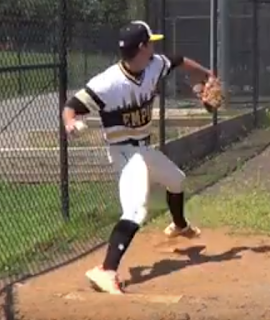Your mind wants to keep your body in balance.
For example, anytime your mind senses you’re falling, to
keep you from hurting yourself, your mind instantaneously takes control of your
every movement.
Being in balance.
“Being in balance” is ending your front leg lift with
your weight centered between your knees.
·
At the top of your front leg lift, you can
freely move your arms and legs.
·
To move down the mound, you first
movement out of your front leg lift is opening your front shoulder.
·
To keep you from falling on your nose,
you have no choice but to stride.
·
Because your stride interrupts your lower
body rotation, you force your mind to overreact in a very productive way.
·
When you end your stride and stop your
lower body rotation, not only do you completely change your body’s dynamics, but
your mind receives another alert.
·
To keep from hurting yourself and to get
your body back in balance, your mind forces you to make a throwing action, and,
since your throwing action is an involuntary reflex, you know your body will deliver
every pitch directly into your Catcher’s target.
As a spontaneous reaction, you challenge every opponent to
make solid contact with any pitch you throw.
Feeling balanced.
“Feeling balanced” is ending your front leg lift with no
space between your knees. To “feel balanced”, you end your front leg lift with your
weight over your back foot.
·
To move down the mound, you’re forced to tilt
your body toward your target.
·
The instant your mind senses this forward tilt, your
mind instinctively uses your throwing arm to slow your movement down the mound.
·
As soon as your front foot gets back on the
ground and your mind senses you’re no longer in danger, you can use your
throwing arm to complete your delivery.
When you let this happen…
·
Your throwing action becomes a secondary, yet somewhat
restricted, action.
·
Your throwing arm path is influenced
by your body position at the end of your stride.
·
The conflict between the throwing arm path you want
and the throwing arm path your body needs means you can't expect your ball to always
end up where you want.
As an unfortunate consequence, when you challenge
your body’s natural throwing arm path, you create the small ligament tears and
fraying that lead to throwing arm distress.
What’s holding back your elite command?
The only
thing holding you back from elite command is knowing how to end your front leg
lift with your weight centered within your knees.
Teaching you
how to end your front leg lift with some distance between your knees takes less
than 10 minutes. If you need help with this, please contact
us.
Skip Fast
Expert Pitching Coach
Professional Pitching InstituteCell or Text: 856-524-3248
E-Mail: skip@propitchinginstitute.com
Copyright © 2018

No comments:
Post a Comment